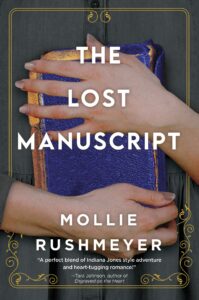By Mollie Joy Rushmeyer, @mollierushmeyer
We hear a lot about using deep POV, all of the five senses, showing emotion through actions instead of telling how the character feels, ramping up suspense and tension through obstacles and dialogue, et cetera. Those are all true. But there’s an often forgotten tool in the author’s toolbox–the setting itself. The setting is simply the time and place your story takes place and there may be multiple settings throughout the book. When done right, the setting can lay the foundation for the tone of the scene or the entire story, act as a friend/confidant or even an antagonist for the main character, mirror the emotions or circumstances of the protagonist, and become a deeper metaphor for the inner psyche and the lies/truths the hero or heroine believes.
This is probably a simplistic illustration, but something occurred to me as I was watching the new Peter & Wendy movie with my family recently. (Sorry, I still prefer the 2003 live-action version!) It struck me afresh how Neverland is like Peter Pan’s innermost self on display and changes as he, himself changes throughout the story. At first, you see the playful, childlike wide-eyed wonder side of Neverland. It’s a place where you never have to grow up or answer to anyone–just the way Peter wanted. But as the story progresses, you see it’s not all sunshine and rainbows. Peter grapples with a burgeoning young love for Wendy, longing for but also resentment toward his mother, and all he fears about growing up. He literally wrestles with his own shadow throughout the story! As these struggles become more and more pronounced, the paradise of Neverland takes on a darker, more sinister tone as Peter’s mood turns angry, stubborn, and often morose.
This shift isn’t hitting the viewer over the head. It’s subtle. That’s why I call the setting our camouflaged secondary character. It should enhance but not take over the characterization and emotion that’s already there.
I’d like to share an example from my book, The Bookshop of Secrets. Hope Sparrow is a survivor of human trafficking, trying to start over, and arrives in Wanishin Falls, Minnesota to collect a set of first-edition antiquarian books her mother left for her. The story takes place in a small town on the edge of Lake Superior. For a young woman who had all of her choices taken from her for so long, had no control over what was happening to her, and didn’t know what was going to happen next–the deep churning waters of Lake Superior are a frightening place. But it’s also a place where she can learn to face these fears. The waters become a metaphor for trusting what we cannot see, putting our faith in the One who created the waves, who does see ahead and is in control.

This is Hope: “…I guess the thought of the waves pushing and pulling me, being out of control, frightens me. And the not knowing what’s under there, watching, waiting. I don’t know…” The hairs on her arms stood on end with a dark memory trying to push its way to the surface. “It’s sort of terrifying. At the same time, I can’t seem to look away.”
… Mags went on, “Trust. Faith. It’s a difficult thing when we have our eyes on the waves instead of on the One who commands them. We can get so lost in the depths of our circumstances, we forget to look up.”
You can super-charge your setting to its fullest potential by:
- Being intentional about choosing settings/locations, the weather, time of day, what objects or natural landmarks are in the surroundings, etc. Not every setting needs some profound meaning, but perhaps choose at least 1-2 major setting(s) that can help bring your characters and their emotional journeys to life.
- Having the setting sometimes match the mood of the scene and other times, let it juxtapose what is happening or what the characters are feeling. This is a little cliche, but here are a couple of simple examples: Have a bright sunny day in a beautiful location while your protagonist is dealing with emotional turmoil or the antagonist carries out his/her dark schemes. Or vice versa, “it was a dark and stormy night” when your hero and heroine finally admit they love each other or at least, don’t hate each other. 🙂
- Show your setting through worldbuilding right at the beginning of the story to give that sense of place and how it may affect your hero’s/heroine’s in terms of their emotions, goals, and truth/lies. But don’t overwhelm with too much detail right off the bat. Let the “character” of your setting be woven gracefully into dialogue and small amounts of narrative/self-reflection throughout.
- Use your metaphors wisely. Using symbolism with a light hand (hopefully, like the example I shared from my book above) will give the reader a deeper insight into the characters you want them to cheer for.
I’ve always wanted to give my setting a secret name. Let me know if you think of one for yours. Happy writing!
In the vein of The Library of Lost and Found by Phaedra Patrick, a priceless manuscript could be one woman’s key to finding her missing grandmother—and to her own second chance.
It’s not just Ellora Lockwood’s home that’s being emptied as she prepares to sell—her heart seems to be empty too. Since the mysterious disappearance of her beloved Grandma June and separating from her husband, Alex, Ellora has felt adrift. Then comes an invitation from Alex to teach history at a summer program at Alnwick Castle in England. He’s even found information about the location of a medieval manuscript that was her grandmother’s obsession before she vanished.
Warily, Ellora accepts Alex’s offer. Surrounded by lush English countryside and captivating history, she pieces together clues about the manuscript’s whereabouts—and uncovers new questions. Could someone have been sabotaging her grandmother’s work? Anonymous threats lead Ellora to suspect she too may be in danger, but as she and Alex work together, she’s finding strength, new purpose and the courage to see this quest through, wherever it may lead…

Mollie Joy Rushmeyer writes “Contemporary Fiction with a Heart for History.” She loves to write inspirational fiction in contemporary settings with fascinating historical elements, people, objects, and stories woven throughout. A modern girl herself, she wouldn’t want to go a day without modern plumbing. But she’s always felt a special connection to the past. The legacies and lives left behind are like gifts waiting to be unwrapped, and she shares this blend of history and contemporary living with readers.
A born and bred Midwestern gal, Mollie, makes her home in Minnesota with her husband and two spunky daughters. She is not only a bibliophile (the dustier the better, in her opinion), she’s a true anglophile at heart. Tea and coffee fuel her travels, by Google maps at least, and her passion for the written word.
Her debut novel, The Bookshop of Secrets, with Love Inspired Trade/Harlequin released October 25th, 2022. And her second, The Lost Manuscript, will be available August of 2023.
She’d love to connect through social media: https://www.facebook.com/mollie.rushmeyer and https://www.instagram.com/molliejoyrushmeyer/
And don’t forget to sign up for her newsletter (visit molliejrushmeyer.com) for vintage recipe reboots, history mixed with modern living, tea and book pairings, exclusive giveaways, and a FREEBIE pdf download “10 Vintage Hacks for Modern Homes.”


